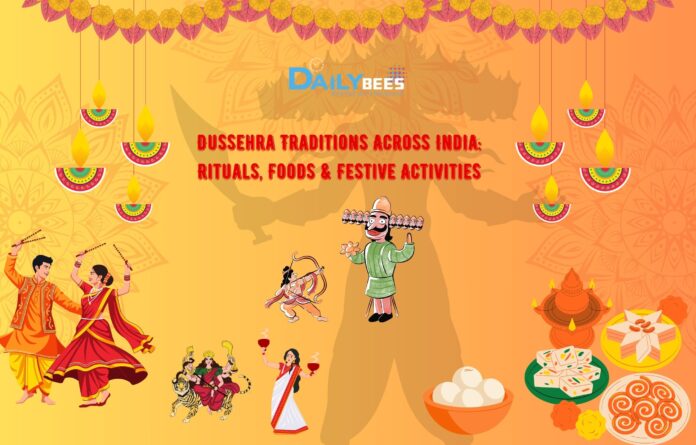Table of Contents
I. Introduction
Every year, Dusshera arrives with the vibrant reminder that light always conquers darkness and virtue outshines vice. More than just a festival, it is a story woven into the very cultural and spiritual fabric of India. At its heart lies the universal theme of the triumph of good over evil, one that resonates across generations and geographies.
This guide takes you through the foundation of Dusshera—its historical roots, spiritual symbolism, and cultural impact. Together, let us celebrate Dusshera not just as a festival, but as a personal journey of reflection and renewal.

II. Understanding Dussehra: The Foundation
- Historical and Mythological Background
Dusshera carries with it two of the most powerful stories in Indian mythology. In the Ramayana, Lord Rama’s victory over the ten-headed Ravana marks the end of tyranny and the restoration of dharma. Equally significant is the tale of Goddess Durga, who defeated the mighty demon Mahishasura after a fierce battle lasting nine nights. These legends, though different in origin, converge on one powerful truth—the triumph of good over evil.
- Spiritual Significance
On a spiritual level, Dusshera symbolizes the inner battles each individual faces. It is not only about external enemies but also about conquering anger, greed, and ignorance within ourselves. By choosing to celebrate Dusshera, people reaffirm the timeless lesson that righteousness and truth eventually prevail. The festival serves as a reminder that real victory lies in personal transformation and moral courage.
- Cultural Importance
Beyond mythology, Dusshera is a cultural bridge that unites communities across India. From dramatic Ramlilas in the north to vibrant processions in the south, every region adds its own unique flavor. Families gather, stories are retold, and traditions are passed down, strengthening generational bonds. In a diverse country, Dusshera becomes a common thread of unity, reminding us that while customs may differ, the values celebrated remain universal.
III. Traditional Dussehra Celebrations Across India
- Northern India Traditions
In northern states, the most iconic sight during Dusshera is the Ramlila—dramatic enactments of the Ramayana. Performed in villages and cities alike, these plays build up to the moment of Rama’s victory over Ravana. The highlight of the celebration is the burning of Ravana’s towering effigies, often accompanied by fireworks, symbolizing the destruction of evil.
Delhi’s Red Fort hosts some of the grandest celebrations, where thousands gather to witness the spectacle under a backdrop rich with history and grandeur.
- Eastern India (Durga Puja Connection)
In the east, Dusshera beautifully blends with the conclusion of Durga Puja.
- In West Bengal, the day is marked as Vijaya Dashami, a farewell to the Goddess after nine days of devotion.
- Married women participate in the joyful Sindoor Khela, applying vermillion to each other as a gesture of strength, unity, and blessings.
- The festival culminates with the emotional immersion of Goddess Durga’s idols in rivers or seas, a ritual that symbolizes her return to her celestial home while leaving behind her blessings.
- Southern India Celebrations
Southern India celebrates Dusshera with equal grandeur but distinct flavors.
- Karnataka’s Mysore Dasara is legendary, where the illuminated Mysore Palace becomes the heart of cultural and royal festivities.
- In Tamil Nadu, Dusshera connects deeply with Navarathri, where families set up decorative displays of dolls called Golu to narrate stories of gods and saints.
- Andhra Pradesh has its own tradition called Bommala Koluvu, where beautifully arranged figurines bring mythological tales to life, blending devotion with creativity.
- Western India Observances
In the western states, Dusshera brings communities together through music, dance, and cultural gatherings.
- Gujarat shines with its energetic Garba and Dandiya performances, where devotion merges seamlessly with celebration.
- Maharashtra observes the day with symbolic exchanges of apta leaves, considered tokens of prosperity, and with vibrant community gatherings that strengthen social bonds.
- Rajasthan adds a regal flavor, with its historic forts and palaces hosting royal processions and grand performances, reflecting the state’s rich cultural heritage.
IV. Essential Dussehra Activities You Can Participate In
- Religious and Spiritual Activities
At its core, Dusshera is deeply spiritual.
- Many people begin the day with visits to temples, offering prayers to Lord Rama or Goddess Durga.
- Special pujas are conducted, to seek blessings.
- Fasting is a common practice, often accompanied by meditation to purify the mind and body.
- Reading sacred texts such as the Ramayana is another meaningful way to honor the occasion, as it retells the timeless story of courage and dharma.
- Community Celebrations
The spirit of togetherness truly shines during community events.
- Local Ramlila performances provide entertainment while imparting moral lessons, making them popular across towns and villages.
- The burning of Ravana’s effigies is not only symbolic expression of rejecting evil.
- Attending cultural programs such as music, dance, and theater performances further enhances the festive spirit.
- In many areas, large community feasts are organized, where families and neighbors share traditional meals, reinforcing bonds of unity and joy.
- Educational Activities
Dusshera also offers opportunities for learning, especially for younger generations.
- Storytelling sessions for children help them understand the significance of Lord Rama’s virtues or Goddess Durga’s strength.
- Schools and cultural organizations often host mythology workshops or drama competitions to encourage curiosity about India’s rich heritage.
- Dance performances, especially depicting episodes from the Ramayana, bring mythology alive in engaging ways.
- Creative art and craft sessions, such as making Ravana masks, drawing mythological scenes, or designing festive decorations, allow children to celebrate Dusshera with both imagination and knowledge.
- Family Traditions
Families often create their own meaningful ways to celebrate Dusshera.
- Homes are decorated with rangoli, torans, and fresh flowers, while lamps and candles brighten the festive night.
- Special meals are prepared, with dishes varying across regions—from sweets like jalebi in the north to festive rice delicacies in the south.
- Family gatherings become moments of storytelling, prayer, and reflection, where elders bless younger members as a gesture of love and guidance.
These traditions, whether small or elaborate, create lasting memories that strengthen family bonds.
V. Creating Your Own Dussehra Celebration at Home
- Home Decoration Ideas
Start by creating a festive atmosphere with traditional décor.
- Simple rangoli patterns at the entrance welcome positivity and prosperity.
- Marigold flowers, known for their bright hues and fragrance, can be used to adorn doors and windows.
- Lighting diyas or candles in the evening not only enhances the beauty of the home but also symbolizes the victory of light over darkness.
- Adding religious artwork, such as images of Lord Rama or Goddess Durga, completes the sacred setting.
You can decorate your office space as well.
- Prayer and Ritual Setup
Setting up a small home altar can bring the spiritual essence of Dusshera indoors.
- Place idols or pictures of deities, along with incense sticks, flowers, and lamps, to create a serene space.
- Preparing essential prayer items such as fruits, sweets, and holy water ensures a smooth puja.
- Following the vidhi (ritual procedure) of reciting mantras or chanting the Ramayana verses makes the celebration both traditional and deeply personal.
- Family Activity Planning
To keep the festival interactive, plan activities that involve all family members.
- Narrating the story of Rama and Ravana.
- Traditional indoor games add an element of joy, while costume play—such as dressing up as mythological characters encourages creativity.
- For younger children, craft projects like making paper effigies of Ravana or designing small rangoli cards can keep them engaged and connected to the essence of Dusshera.
VI. Special Foods and Feasts for Dussehra
- Traditional Recipes
Food is an inseparable part of Dusshera celebrations.
- In the north, dishes like poori, aloo sabzi, and jalebi dominate festive tables
- The south highlights tamarind rice, sundal, and sweet payasam.
- Many households offer prasadam such as halwa or coconut-based sweets, alongside varieties of laddoo and kheer.
- Community Feast Ideas
Community feasts are another highlight of the festival.
- Local groups often organize potlucks, where each family contributes a dish, turning meals into opportunities for cultural exchange.
- Shared food not only strengthens social bonds but also keeps alive regional culinary traditions.
- Organizers often consider dietary needs, making celebrations inclusive and joyful.
- Modern Adaptations
Modern households experiment with fusion dishes—millet-based sweets, spiced wraps, or mini Ravana cupcakes. Quick recipes and kid-friendly options ensure the spirit of Dusshera is enjoyed even in busy urban lives, making food both festive and fun.
VII. Modern Ways to Celebrate Dussehra
- Digital Age Adaptations
The digital world has opened up fresh avenues for celebrating Dusshera.
- Families separated by distance can join virtual pujas or watch live-streamed Ramlila performances.
- Online community groups organize cultural discussions, while social media platforms allow people to share festive greetings, photos, and even short storytelling reels about the Ramayana.
- Digital platforms make it possible for traditions to reach global audiences with ease.
- Eco-Friendly Celebrations
Sustainability has become a key focus in recent years.
- Instead of synthetic décor, many households now opt for rangoli made with flowers or rice flour, reusable diyas, and clay idols.
- Community events also promote waste-free feasts by using biodegradable plates and managing leftovers responsibly.
These practices ensure that Dusshera celebrations remain joyful while being kind to the environment.
- Fusion Celebrations
In multicultural cities, Dusshera often takes on new forms.
Fusion events may combine Indian traditions with global cultural activities, such as music concerts, art exhibitions, or theater workshops. Contemporary venues like auditoriums, parks, or even online platforms host these celebrations, making them accessible to diverse communities.
- Budget friendly celebration tips
Celebrating Dusshera doesn’t have to be expensive.
- DIY decorations, homemade sweets, and simple potluck gatherings keep costs manageable.
- Free community programs, such as local dramas or storytelling sessions, add value without strain.
- With creativity and resourcefulness, anyone can celebrate the spirit of Dusshera meaningfully, regardless of budget.
VIII. Planning Your Dussehra Week
- Pre-Celebration Preparation
Begin with a simple shopping list covering essentials like flowers, diyas, rangoli colors, festive clothes, and ingredients for traditional recipes. Coordinate with family or friends if you’re hosting, sending out invitations early. Prepare decorations in advance—torans, lights, and art pieces—to set a festive mood. Food planning, whether for home feasts or community gatherings, ensures smooth celebrations without last-minute stress.
- Day-of-Festival Activities
On the festival
- Start the morning with rituals, temple visits, or home pujas to invite blessings.
- Afternoons can be devoted to storytelling sessions, cultural programs, or preparing special meals.
- Evening highlights often include Ramlila performances, effigy burning, or family get-togethers.
- Nighttime brings the concluding ceremonies—lighting diyas, offering prayers, and enjoying sweets together.
- Post-Festival Activities
After the celebrations, try to reflect on the festival’s meaning, expressing gratitude for togetherness and blessings received.
Share memories through photos, videos, or journals to preserve the spirit of Dussehre.
Try to keep the faith and purity alive in your heart for the times to come.
IX. Conclusion
Dussehra is not only about tradition but also about personal growth. By participating mindfully—whether through prayer, eco-friendly practices, or community events—you embrace the timeless spirit of good triumphing over evil.
Share your family’s unique Dussehra traditions in comments and let this guide become a space for exchanging cultural joy.
Finally, carry the celebration beyond your home. Tag us in your Dussehra celebration photos, inspire others, and together let’s keep this festival alive with unity, creativity, and gratitude.
Bookmark this guide for your Dussehra planning and step into the festival with clarity and joy. From rituals and feasts to crafts and digital innovations, every idea here is designed to make the celebration meaningful and memorable.













